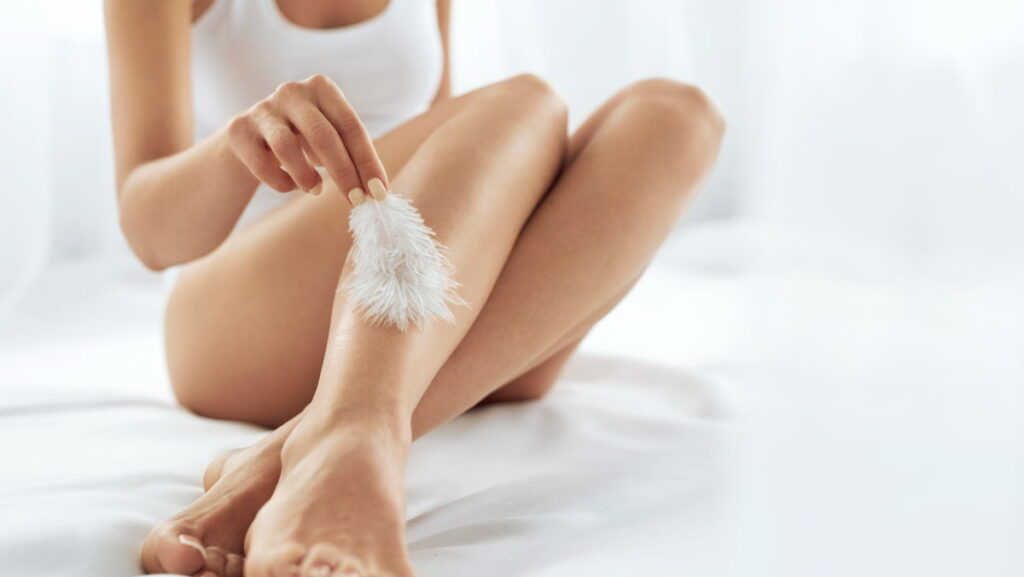
In the realm of beauty and self-care, depilation stands as one of the most prevalent practices. As technical as the term may seem, it only means hair removal. From a historical perspective, depilation can be traced back to ancient civilizations.
Some common examples of depilation techniques are shaving or waxing. This practice is not limited to one gender or age group – it’s a universal aspect of grooming, contributing to an individual’s overall appearance and self-perception.
The significance of depilation is multi-faceted. It’s important to take care of your personal hygiene. Who would deny having clear skin with reduced body odor?
Many people use depilation in their beauty routines. Of course! Who doesn’t want to have smooth and silky skin? Depilation can act as a form of self-expression for many people. It’s a personal choice that reflects one’s style, comfort, and confidence.
Different depilation methods work for different body parts. Since each individual varies with skin type, hair type, personal preference, and budget, it’s important to select which method works best accordingly.
This guide will answer all your questions about whether you want hair removal for aesthetic reasons or personal care reasons. We’ll look into various depilation techniques available, their pros and cons, and how to select the best method for you.
What Is Depilation
Depilation is basically removing hair from the surface of your skin and can be done in a few ways, like shaving, waxing, plucking, or using depilatory creams.
Keep in mind that depilation is only a temporary hair removal method, so the hair will grow back after some time. It’s different from epilation, which removes hair from its root.

Different Depilation Techniques
It’s important to learn how each method works to make a decision. Each varies in terms of pain, cost, and effectiveness. Here are five of the most commonly used depilation techniques:
Shaving
Shaving is perhaps the most common and accessible method of hair removal. It works by trimming the hair at skin level with a razor. Just grab a razor and trim off the hair from the surface of your skin.
You won’t feel any pain during the shaving process, but it can cause skin burns and skin cuts. On top of that, the results are temporary, often lasting only a day or two.
Regular exfoliation is recommended to prevent ingrown hairs. For a better guideline, you can read more about shaving here.
Waxing
Waxing involves applying a layer of wax to the skin, which adheres to the hair. The wax is then quickly pulled off, removing hair from the root.
This technique can lead to smoother skin for a longer period, typically 3 to 6 weeks. It can be a painful experience, especially if you have sensitive skin.
Mastering the art of Brazilian wax or other waxing techniques can be beneficial for longer-lasting results.
Epilation
Epilation uses a device called an epilator, which removes hair by mechanically grasping and pulling them out from the roots.
Much like waxing, it removes hair from the root and can provide smooth skin for up to 4 weeks. However, it may cause discomfort during the process. Read more about epilation on our website.
Laser Hair Removal
Laser hair removal is a more permanent solution. It works by using light to target the pigment in individual hairs. In laser hair removal, the beam of light inhibits hair growth by traveling down the hair shaft into the hair follicle.
While this method can be costly, it offers long-term results and may reduce hair growth permanently over time. Check out our detailed guide on laser hair removal.
Depilatory Creams
Depilatory creams, or hair removal creams, work by breaking down the protein structure of the hair, causing it to dissolve and be easily wiped away.
Although the process is painless, the results do not last for long, barely for just a week.
It’s important to patch-test the cream first to avoid skin irritation. For a more thorough understanding, explore our article on hair removal cream.
Pros and Cons of Each Depilation Technique
When it comes to depilation, there’s no one-size-fits-all solution. The best method for you depends on your preferences, skin and hair type, and the area you want to treat.
The primary factors are time and effort involved, pain and discomfort, longevity of results, and cost and accessibility.
Time and Effort Involved
- Shaving is the quickest method but requires daily or every-other-day maintenance to keep your skin smooth.
- Waxing and epilation are more time-consuming initially, but their results last longer, reducing the overall effort.
- Laser hair removal and depilatory creams require less frequent application, but each session can take longer than shaving or waxing.
Pain and Discomfort
- Shaving and depilatory creams are generally painless but can cause irritation or allergic reactions in some people.
- Waxing, epilation, and laser hair removal can cause discomfort during the process, but this tends to lessen with regular sessions as your skin adjusts.
Longevity of Results
- Shaving and depilatory creams provide short-term results, with hair typically regrowing within a few days.
- Waxing and epilation pull hair out at the root, resulting in smoother skin for several weeks.
- Laser hair removal offers the longest-lasting results, with many people seeing a significant reduction in hair growth after several sessions.
Cost and Accessibility
- Shaving, depilatory creams, and epilation are relatively inexpensive and accessible, with tools and products available at most drugstores and supermarkets.
- Waxing can be done at home or at a salon, with salon treatments generally being more expensive but providing better results.
- Laser hair removal is the most expensive option and usually requires multiple sessions at a specialist clinic, but it’s becoming more accessible with the advent of at-home laser hair removal devices.
| Depilation Technique | Time & Effort | Pain & Discomfort | Longevity of Results | Cost & Accessibility |
| Shaving | Low | Low | Short-term | Low |
| Waxing | Medium | High | Long-term | Medium |
| Epilation | Medium | High | Long-term | Low |
| Laser Hair Removal | High | Medium | Permanent | High |
| Depilatory Creams | Low | Low | Short-term | Low |
Remember, the “best” depilation method depends on your personal preferences and circumstances. For example, if you have sensitive skin, you might prefer a less painful method like shaving or using a depilatory cream.
Or, if you’re after long-term results and don’t mind a bit of discomfort, waxing, epilation, or laser hair removal might be right for you.
How To Choose the Right Depilation Technique
How do you know which depilation method work best for you? Let’s find out.
Skin Type
Your skin type plays an essential role in determining the most suitable hair removal method. For instance, if you have sensitive skin, you may find some techniques more irritating than others.
Shaving or hair removal creams may cause rashes or skin burns, while waxing can lead to ingrown hairs. On the other hand, laser hair removal or IPL hair removal might be a more comfortable option.
Hair Type
The nature of your hair – its density, coarseness, and growth rate also determine the depilation methodology.
Thick, coarse hair may be better managed with waxing, epilation, or laser treatments. In contrast, fine hair can be easily removed through shaving or depilatory creams.
Personal Preference
Your personal preference is also paramount. Whether you prioritize speed, comfort, or long-term results, your personal preference should factor into your decision-making process.
For example, if you prefer a quick and painless method, shaving might be your go-to. If you’re looking for longer-lasting results and don’t mind a bit of discomfort, you might opt for brazilian wax or laser hair removal.
Budget
Different depilation techniques come with varying price tags. Shaving and depilatory creams are typically more budget-friendly, while laser hair removal and epilation devices require a more substantial initial investment. But don’t forget that it provides long-term cost-effectiveness.
Area of the Body
Lastly, the body area you wish to depilate can significantly influence your choice of method.
Delicate areas such as the face or bikini line may benefit from gentle options such as threading or sugaring, while larger areas like the legs or back may be more efficiently handled with waxing or laser hair removal.
Selecting the right depilation technique is a personalized process that depends on various factors.
By considering your skin type, hair type, personal preference, budget, and body area, you can choose a method that’s comfortable, effective, and convenient for your needs.

Depilation Care Tips
Just as every masterpiece requires a well-prepared canvas, successful depilation needs meticulous preparation and post-care to yield the best results.
Here, we offer you proven tips to enhance your hair removal experience, regardless of whether you opt for shaving, waxing, or more advanced techniques like laser hair removal.
Pre-Depilation Prep
Before diving into the depilation process, there are a few steps you should take to ensure your skin is primed for optimal results.
Firstly, cleanse your skin thoroughly. This helps to remove oils and dirt that may interfere with the depilatory method you choose.
Follow this up with a gentle exfoliation to get rid of dead skin cells. This not only allows for a smoother application of depilatory creams or a closer shave but also reduces the risk of ingrown hairs.
Secondly, hydrate your skin. This may seem counterintuitive, especially if you are preparing for waxing, but well-moisturized skin is less prone to irritation.
Just ensure to do this a day before your depilation, not directly before, as creams or oils can interfere with certain hair removal methods.
Lastly, trim your hair if it’s too long. This is particularly important when waxing or using an epilator, as shorter hair is easier to remove and causes less discomfort.
Post-Depilation Care
After depilation, your skin might be sensitive, and it requires some tender loving care to soothe and repair it.
Immediately after depilation, cool your skin with a cold compress or aloe vera gel. This can be particularly soothing following methods like waxing or laser hair removal.
Next, hydrate and soothe your skin with a fragrance-free moisturizer or lotion. Look for products that contain calming ingredients, like chamomile or aloe vera. Avoid products with alcohol or heavy fragrances, as they can cause irritation.
A few days post-depilation, start exfoliating your skin gently to prevent ingrown hairs, particularly if you have chosen methods like shaving or waxing.
Lastly, protect your skin from the sun. Post-depilation, your skin is more sensitive to UV rays and can easily get sunburned.
Apply broad-spectrum sunscreen whenever you step out, especially if you have opted for techniques like laser hair removal or epilation.
Conclusion On Depilation Techniques
In the labyrinth of depilation techniques, knowledge is your most potent ally. The power to choose, the understanding to decide, and the wisdom to select the most suitable method for your unique needs all lie within your grasp.
With all the details, tips, and information in this guide about Depilation, you’re probably now aware of hair removal, from traditional shaving and waxing to modern marvels like laser hair removal.
We understand the need of each individual; therefore, the guide thoroughly covers the advantages and drawbacks of each depilation technique, taking into account factors such as time and effort involved, pain and discomfort, the longevity of results, as well as cost and accessibility.
Taking care of your skin pre and post-depilation is equally crucial. Comfort, aesthetics, and hygiene are all covered when you’re taking good care of your skin.
Remember, there’s no one-size-fits-all solution to unwanted hair. What works for one person may not necessarily work for you, and vice versa.
The journey to smooth, hair-free skin can be riddled with confusion, but it doesn’t have to be. With the right knowledge, every step you take is a confident stride toward ultimate skin satisfaction.
